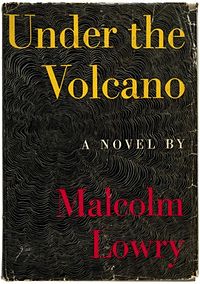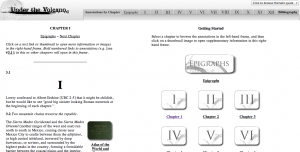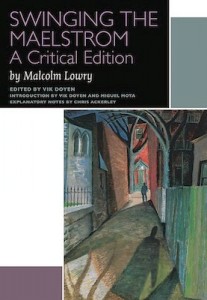Community
January 10, 2014
What It Means to Annotate: Chris Ackerley talks text, context, and the universal library
This post is written by Chris Ackerley of the University of Otago.
Annotating Malcolm Lowry’s Swinging the Maelstrom
Lowry came to my attention, many moons ago, when I was doing my PhD at the University of Toronto. I was sitting, I recall, in the dining room of Hart House, solving the problems of the invisible universe, when somebody came along, and said: “You are working on Joyce. I think you’ll like this”; and left me a copy of Under the Volcano. He was right. I was. I did. I went home that evening and began to read. Some days later, having reached the end, I did what I only later appreciated the novel’s “trochal” structure required me to: I re-read chapter I, now as XIII, and before really being aware of doing so I was into my second (and richer) reading. This probably contributed to my liking of the story Lowry tells, of somebody who borrowed a copy of Ulysses and returned it the next day: “Yes. Thank you. Very good.”
When I came to the University of Otago (New Zealand) one of the first things I saw in the student ghetto was a run-down dwelling apparently held together by a large placard: “The Farolito”. This was a good sign. It transpired that one of my colleagues was also a fan of the novel, and had introduced UTV into the undergraduate syllabus (back in those days when undergrads read), leading to booming sales at the campus pub; we must have been one of the first places, outside Canada, to teach this text. And when my first sabbatical rolled around, not having a clue about what ‘research’ entailed (we were hired to teach in those days), I decided that Mexico would be a good place to visit (it was), and that UTV was a good excuse to go there (indeed). Fortunately, I went via Vancouver, where I visited the Lowry Special Collection at UBC, met Anne Yandle who immediately adopted me as one of her many Lowry proteges, and Bill New, who said that if I found anything interesting in Cuernavaca then how about sending it to Canadian Literature. And UBC Press held out a tantalising possibility of publication, if I could meet their standards….
And find interesting things I did, indeed. Reading the novel in the town in which it was set gave its events both an immediacy and an intimacy, and while I was conscious that much had changed I was smart enough, despite my naivety, to realise that more would do so if it were not recorded. And it was there, perhaps, that I first truly learned to appreciate the way that things in books are not simply things in books, but rather part of a complex life that, however fragmented and ravished by time, is in turn part of a greater process. I also began to collect, often haphazardly, some of the Lowry materials that would eventually end up on my Lowry web-site: http://www.otago.ac.nz/englishlinguistics/english/lowry/
More by instinct than intellect, I began to develop an annotative sense, one generated partly out of a love of general knowledge in turn provoked by stamp collecting (“philately will get you everywhere”), but equally out of the influential study by E.D. Hirsch, Jr., Validity in Interpretation (1967), which remains my bible to this day. Hirsch offers as his working assumption the hermeneutic principle that “each interpretive problem requires its own distinct context of relevant knowledge” (vii); this constitutes equally the foundation of my annotative practice, an axiom of validity in annotation. The pragmatic problem, then, is to determine in both principle and practice how an “interpretive problem” and its “distinct context of relevant knowledge” might be identified. Broadly, this entails accepting Hirsch’s definition of the goal of valid interpretation as consensus, the winning of firmly grounded agreement that one set of conclusions is more probable than others (ix). My additional argument would be that this scientific discipline leads to readings that are richer than those generated by the relativism and polysemy of many contemporary approaches, precisely because of the constraints exerted by the dynamics of text and context.
An example is in order (one plucked from Hugh Kenner, The Pound Era (1971]): the ‘Song’ from Shakespeare’s Cymbeline, with its ingenuous couplet:
“Golden lads and girls all must
As chimney-sweepers, come to dust.”
An annotation might assume as the ‘interpretive problem’ the image of ‘golden lads’, and postulate as constituting its distinct context of relevant knowledge such matters as: (i) the contrast of youth and age, (ii) the exploitation of children as chimney-sweeps, (iii) the pun on ‘come to dust’, (iv) the contrast of gold, that braves time, with dust, the wages of mortality, (v) the chill of closure created by the rhyme of ‘must’ and ‘dust’, (vi) the echo of Genesis 3.19: ‘for dust thou art, and unto dust shalt thou return’ and (vii) perhaps, the song as recycled in Virginia Woolf’s Mrs Dalloway and Beckett’s Happy Days. These details could be woven into an articulate cloak that accentuates the poignant contrast between rhythmical lightness and thematic gravitas. Such an annotation would be valid, but the interpretation ventured might be modified by new information (that is, by changes to the context of relevant knowledge). In The Pound Era (122), Hugh Kenner says ‘golden’ is a magical word that so irradiates the song that we barely consider how Shakespeare may have found it: “Yet a good guess at how he found it is feasible, for in the mid 20th century a visitor to Shakespeare’s Warwickshire met a countryman blowing the grey head off a dandelion: ‘We call these golden boys chimney-sweepers when they go to seed.’” And suddenly all is clear: dandelions that wilt in the heat of the sun and cannot endure the winter’s rages, now as an image both startlingly new yet reassuringly familiar: death as the blowing of a common flower. What is striking about this image (in my direct experience, and that of most of my students on whom I have tested it), is that something that earlier was not perceived (indeed, was earlier not perceptible) has been somehow precipitated into consciousness, so that the ‘meaning’ seems to have altered; an entity not ‘there’ on one reading is revealed as a presence, a given, on another, though the lines are unchanged. There would be general consensus, I imagine, that an interpretation that accounts for (that is, admits into the distinct context of relevant knowledge) the dandelion is likely to be better (that is, of greater explanatory power) than one that does not. My hope as an annotator is to enhance this kind of awareness.
The arena of annotation then, is broadly the no-man’s land between text and context. Annotation partakes of the editing process, in that its first principle must be the best possible text; and it partakes of critical evaluation, by determining the appropriate weighting of the factors that should or should not be taken into consideration. This is an impossible process. I recall vividly a moment that made me want to throw Under the Volcano into the barranca. I had not considered that there was anything to say about the moment in Chapter IV when Yvonne, trying to get Geoffrey out of Mexico, thinks about owning a farm with “cows and pigs and chickens”; but, much later, looking at Eugene O’Neill’s ‘Bound East for Cardiff’ I read about Yank, a dying sailor, who dreams of dry land, and of owning a farm of his own, with [yes] “cows and pigs and chickens”. Now, a rule of thumb by which I work in determining the presence of allusion is: one echo, so what; two echoes, perhaps coincidence; three, almost certainly evidence of intention. The O’Neill passage had about a dozen points of clear contact with the Lowry detail, but nobody (I was simply lucky) would recognise it as an allusion; and this brought about an existential crisis in my life as an annotator: for if this is an allusion, then what is not?
I found consolation in two unlikely places. Firstly, Joyce’s A Portrait of the Artist, its description of the condition of the soul as approaching ever nearer but never reaching the Creator; then, this sentiment as transfigured at the end of Beckett’s Molloy, where Moran thinks of his bees, and the mystery of their dance (in 1948 a code uncracked), with rapture, with exaltation: “here is something I can study all my life, and never understand.” And there was another gradual intimation: a sense of something that Lowry shares with Borges, of the virtual presence of a Universal Library, Platonic in its nature, in which everything written by anyone, anywhere, is filed, with different degrees of accessibility and retrievability (hence Lowry’s notorious “borrowing”). I once thought, in the arrogance of the days when I knew the answers (now, I am increasingly [or should that be decreasingly??] uncertain of the questions), that this was a mere conceit; it now strikes me increasingly as a profound, if not truth, then at least persuasive hypothesis.
My annotations to Vik Doyen’s editing of Swinging the Maelstrom will not be definitive; they cannot be so. Yet both Vik and I would regard them as an intrinsic part of the process, as something occupying that middle ground between editing and interpretation, invoking the one to guide the other. As Vik has intimated, our work on this text goes back a long way: to the “Western Canadian Deans’ Short Course: The Malcolm Lowry Collection”, that he and I (quite frankly, more him than me, just like this book) taught together at UBC in 1987, where a virtual form of this edition was “taught” as a possible project; to the 1997 Lowry Symposium in Toronto, where the pledge to publish was renewed; to many pleasant hours in Leuven in 1998 with Vik (whose house was burgled the night after I left), and in Miami with Pat McCarthy, working over the text and annotations together; then to the 2009 symposium in Vancouver, which I attended with the sole ambition of eating blueberries in the heat o’ the sun, but came back as part of the EMiC team, committed to six further years of hard labour; and finally to working with the current team of international scholars on this project, and on the two to follow (I might add, parenthetically, that the 2,000 and more annotations to the forthcoming edition of Lowry’s In Ballast to the White Sea, occupying some 200 sensibly-spaced printed pages, represent the toughest challenge of this kind that I have ever faced; and one that would have been impossible—how on earth did I do those early volumes?—without the search engines of the Internet, itself perhaps the palpable manifestation in quotidian life of the Universal Library). T.S. Eliot famously likened the work of the individual writer or critic to that of one of the countless polyps that, working individually, yet make up collectively the greater reef; all I can add is that it has been a masochistic pleasure to have been one of these, and to see that a work that has been, one way or another, “in progress” for about twenty-six years now in the light of day.


